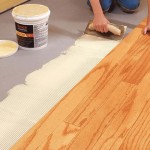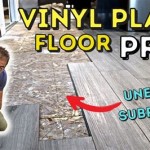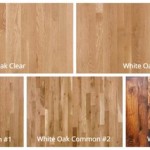Lauzon Flooring Problems: A Comprehensive Overview
Lauzon Flooring is a well-regarded manufacturer of hardwood flooring known for its quality and innovative finishes. However, like any manufactured product, Lauzon flooring can experience problems. These issues can stem from manufacturing defects, improper installation, or environmental factors. Understanding the potential problems associated with Lauzon flooring, their causes, and possible solutions is crucial for homeowners and installers alike.
This article aims to provide a comprehensive overview of common Lauzon flooring problems, focusing on areas where issues are frequently reported. It delves into the potential causes behind these problems and explores strategies for prevention and remediation. The intention is to provide clear and objective information to assist in making informed decisions regarding Lauzon flooring.
Cupping and Crowning in Lauzon Flooring
Cupping and crowning are two common problems observed in hardwood flooring, including Lauzon products. Cupping refers to a situation where the edges of the floorboards are higher than the center, creating a concave appearance. Crowning, conversely, is when the center of the floorboards is higher than the edges, resulting in a convex shape.
The primary cause of cupping is an imbalance in moisture content between the top and bottom of the floorboards. Typically, this occurs when the underside of the flooring is exposed to higher levels of moisture. This can be due to moisture migrating from the subfloor, leaks, or high humidity levels in the crawl space or basement below. The bottom of the board absorbs the moisture and expands, while the top remains relatively dry and stable. This differential expansion causes the edges to rise, leading to cupping.
Conversely, crowning often results from over sanding a floor that was previously cupped. When a cupped floor is sanded flat, the edges are thinned. If the moisture source is eliminated and the wood dries, the edges shrink more than the center, resulting in crowning. In some instances, crowning can also occur if the top surface of the wood gains moisture faster than the bottom, although this is less common.
Preventing cupping and crowning starts with ensuring the subfloor is adequately dry before installation. A moisture meter should be used to verify that the subfloor's moisture content is within the manufacturer's recommended range. Proper ventilation in crawl spaces and basements is also critical to prevent moisture buildup. Addressing any leaks or sources of water intrusion is paramount. During installation, a vapor barrier should be used between the subfloor and the hardwood flooring to further mitigate moisture migration.
Remediation of cupping or crowning depends on the severity of the problem. In some cases, addressing the underlying moisture issue and allowing the floor to acclimate naturally can resolve the problem. This may take several weeks or even months. Dehumidifiers can be used to help lower the humidity levels. For more severe cases, sanding and refinishing the floor may be necessary, but it's crucial to address the root cause of the moisture problem first to prevent recurrence.
Gaps and Cracks in Lauzon Flooring
Gaps and cracks are another prevalent concern associated with hardwood flooring, including Lauzon products. These imperfections can detract from the aesthetic appeal of the floor and, in some cases, compromise its structural integrity.
The primary culprit behind gaps and cracks is fluctuations in humidity. Hardwood is a hygroscopic material, meaning it absorbs and releases moisture from the surrounding environment. During periods of high humidity, the wood expands, while during periods of low humidity, it shrinks. These expansion and contraction cycles can lead to gaps forming between the floorboards, especially during the drier winter months. Cracks can also develop in individual boards if the wood is subjected to extreme swings in humidity or if the wood is inherently weak or defective.
Another potential cause is improper acclimation of the flooring before installation. Hardwood flooring should be allowed to acclimate to the environment in which it will be installed for a specified period, typically several days to a week or more. This allows the wood to adjust to the ambient temperature and humidity levels. Failure to properly acclimate the flooring can result in excessive expansion or contraction after installation, leading to gaps and cracks.
Incorrect installation techniques can also contribute to these issues. If the flooring is not properly secured to the subfloor, or if insufficient expansion gaps are left around the perimeter of the room, the flooring may not have enough room to expand and contract naturally, resulting in gaps or cracks.
Prevention is key to minimizing gaps and cracks. Maintaining a consistent humidity level in the home is crucial. This can be achieved through the use of humidifiers during the winter months and dehumidifiers during the summer months. Ensuring proper acclimation of the flooring before installation is also paramount. Following the manufacturer's recommended installation guidelines, including proper fastening techniques and expansion gap requirements, is essential.
Addressing existing gaps and cracks can be challenging. Small gaps may close naturally during periods of high humidity. Larger gaps can be filled with wood filler, but this is often a temporary solution, as the filler may crack or shrink over time. In some cases, it may be necessary to replace the affected boards. For severe cases of cracking or gapping, professional assessment and repair may be required.
Finish Problems and Wear in Lauzon Flooring
The finish on Lauzon flooring is a critical component, providing protection against wear, scratches, and stains. However, finish problems can arise due to various factors, affecting the appearance and longevity of the flooring.
One common issue is premature wear of the finish. This can manifest as scratches, scuffs, or dulling of the surface. Factors contributing to this include heavy foot traffic, abrasive cleaning products, and a lack of proper maintenance. The type of finish applied to the floor can also play a role. Some finishes are more durable than others, and selecting the appropriate finish for the intended use is important.
Another potential problem is peeling or chipping of the finish. This can occur if the finish was not properly applied, if the surface was not adequately prepared before finishing, or if the finish is exposed to excessive moisture or chemicals. Certain cleaning agents or harsh solvents can damage the finish and cause it to peel or chip.
Inconsistent finish application can also lead to problems. This can result in uneven gloss levels, color variations, or visible brush marks. These issues are typically caused by improper application techniques or the use of substandard finishing products.
Preventing finish problems starts with selecting a durable finish that is appropriate for the intended use. Following the manufacturer's recommended cleaning and maintenance guidelines is essential. Using soft cloths or mops and avoiding abrasive cleaners can help protect the finish. Placing mats at entrances and using furniture pads can also help prevent scratches and wear.
Addressing finish problems depends on the severity of the issue. Minor scratches and scuffs can often be repaired with touch-up kits or by buffing the surface. More severe damage may require sanding and refinishing the affected area or the entire floor. In cases of peeling or chipping, it may be necessary to completely remove the old finish and reapply a new one.
Proper installation of the finish is crucial for long-term performance. This involves ensuring the surface is properly prepared, applying the finish evenly, and allowing adequate drying time. Using high-quality finishing products is also important. Consulting with a professional flooring contractor can help ensure that the finish is applied correctly.
Ultimately, understanding the potential problems associated with Lauzon flooring, their causes, and preventative measures is crucial for ensuring a beautiful and long-lasting floor. By addressing issues promptly and implementing proper maintenance practices, homeowners can maximize the lifespan and aesthetic appeal of their Lauzon flooring.

Lauzon Hardwood Flooring Reviews And Cost 2024

Lauzon Hardwood Flooring Reviews And Cost 2024

Eek My Hardwood Floor Has Gaps Valenti Flooring

Lauzon Prefinish Hardwood Flooring Installation Guide
New Line Of Hardwood Flooring Improves Indoor Air Quality Architect

Lauzon Flooring

The 15 Best Engineered Wood Flooring Brands Reviews 2024 Floorings
Lauzon Flooring Best In Toronto And Mississauga Wood Vinyl Tile Laminate

Pure Genius Lauzon Flooring Hardwood Floors

Wood Floor Cupping Flooring Problems Spotting Trouble
Related Posts








